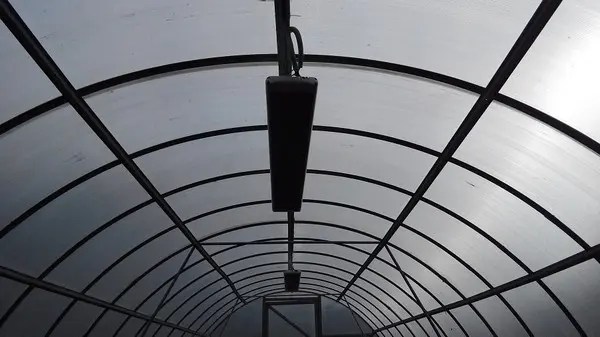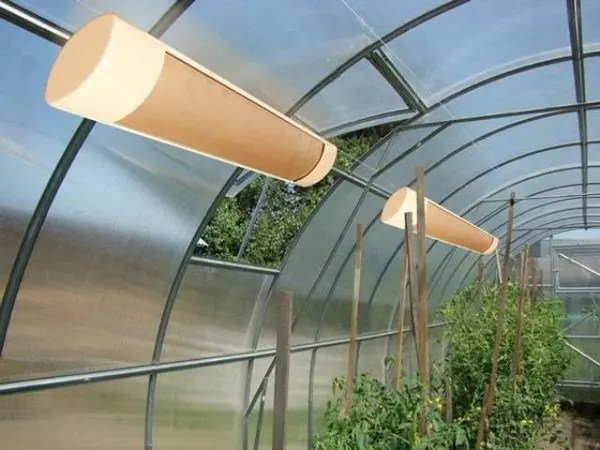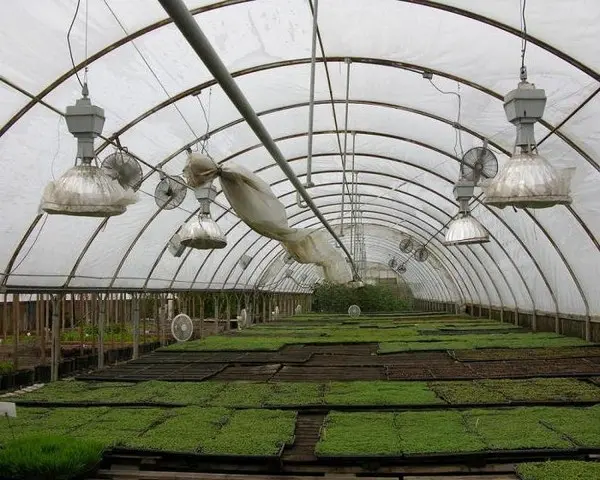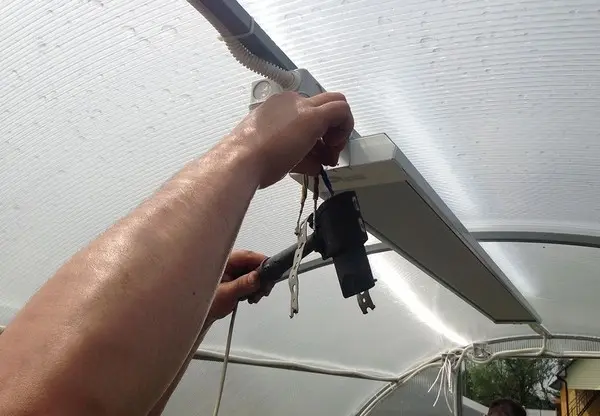Contents
If you properly organize a greenhouse, you can not only provide your family with fresh vegetables all year round, but even get a source of income. In order to grow vegetables in the winter, you need to choose the right heater for the greenhouse. Infrared heating of greenhouses is a modern solution to this issue, it has a number of undeniable advantages over more recently popular types – oil or cable heating.
Advantages of infrared heaters
All types of heaters known to us, with the exception of IR, emit heat, which is then absorbed by objects, that is, they heat the air. Infrared heaters work on the principle of the sun, they emit rays that heat objects and all non-reflective surfaces, and they, in turn, give off the resulting heat to the air. Since the heated air rises, and the plants are at the bottom, and sometimes they need warm soil more than warm air, the invention of IR lamps can be called a real blessing for greenhouses. After all, they heat the soil, the plants themselves and all objects that fall into the coverage area.

Infrared heaters work completely silently, they emit heat useful for plant growth, but do not produce any harmful substances. This heat can be regulated and evenly distributed over the entire required area, without affecting the level of humidity in the room at all. By changing the distance between the IR lamps and the ground, you can create comfortable temperature conditions for all plants, even if their needs are different.
So, having sown seeds in the ground, we will install a lamp at a certain height above it. Over time, when the seedlings sprout and grow up, raising the heat source higher, we will reduce the heating of the earth. Thus, at the time of germination, the seeds will receive a high temperature of the earth, and then, with a change in their needs, the temperature will also change. All this is easy to manage, you can even arrange zones with different temperature conditions for different plants in the same room.
The infrared heater does not provoke air movement, which means it eliminates the presence of drafts that are harmful to many plants. Moreover, you can reduce the damage from cold air entering from doors or windows by placing the heater in such an area with broken thermal insulation. If you correctly calculate the power of IR lamps, then you can use their minimum number to heat the entire greenhouse instead of the entire heating system. The only drawback of such heaters can be considered their high cost. But winter greenhouses are usually created not for one year, but for 2 – 3 years of operation such equipment will certainly pay off.

IR lamps are very practical and easy to use, they take up little space, which is very important for a greenhouse. They have great efficiency at low power, which helps a lot to save electricity, and equipped with a thermostat, they save it even more and reduce the number of owner’s worries.
For greenhouses, there are two types of heaters: ceiling – they are attached to the ceiling or walls, and film – designed to heat the ground. Film can be installed vertically near the ground or buried under plants. The second option is arranged in greenhouses where the soil is not often dug up, where the earth freezes very deeply in winter.
Video “Infrared heating film”
The author of this video will clearly explain to you the benefits of using IR film in the house, which also applies to the greenhouse.
How to choose a model
Infrared heaters are electric, gas or run on liquid fuel. When choosing a model, you need to navigate in advance by the power source. Far from civilization, you can feel completely independent by purchasing a liquid fuel heater. The power supply is considered the most economical, but if there are problems with the electrical wiring, then gas infrared lamps are quite reliable, moreover, gas cylinders can be used.
In industrial greenhouses with a huge territory, light heaters are used, the surface of the emitter can heat up to +600 degrees. Long-wavelength lamps are better suited for small private greenhouses.

The first models had a flat radiation surface, the newer ones have a spherical shape, which allows them to scatter the rays by 120 degrees. Spherical models are more economical when used on large areas, and flat ones – on small ones.
Today you can find infrared heaters from different manufacturers on sale: imported ones will cost more, domestic ones will be cheaper. Of course, you need to choose only from well-known brands, products must be well packaged, have a quality certificate. It is never superfluous to check the integrity of the package and ask the seller for a certificate, as well as issue a warranty card.
The Peony brand has proven itself well. Its product is a round heater with a ceramic heating element, it must be fixed to the ceiling. Models of the Ecoline brand are considered very economical, they are used in large industrial greenhouses and for heating small rooms, they are distinguished by a long service life and high efficiency. The brand “Ballu” is known among fans of gas appliances. It offers very different heaters, among them even high power, which can be used in open areas or in huge greenhouses.
Video “Infrared heat. Expert answer”
In this video, a representative of an IR equipment manufacturing company will tell you about all its advantages.
How to calculate
In order for infrared heaters to work correctly, not only help grow agricultural products, but also save the owners money, you need to correctly calculate the ratio of the power of the devices to the heated area. How to do it? Consider the example of the most common home winter greenhouse in terms of area.
Most often, people arrange approximately such a greenhouse: 3 m wide with a working corridor in the middle, 6 m long, with an entrance from the end. For a greenhouse of this size, just two 1,5 kW panels can be enough, just need to choose the right size. A zone 3 m wide and 2,5 to 3 m long will be covered by rays from a heater 1,7 m long, subject to dispersion of at least 100 degrees – here the height at which it needs to be placed also matters.

If the width of the greenhouse is smaller, and the passage is arranged on the side, then less powerful heaters will be needed. If the width is greater, then you can place them not on the ceiling, but on the side on both sides. In this case, you will need not 2, but 4 heaters, but less powerful ones. When calculating the number and power of infrared heaters, you need to find an option when the entire area of uXNUMXbuXNUMXbthe beds is covered with rays.
Installation
Another advantage of IR heaters is that they are very easy to install, this can be done without the involvement of specialists. The only moment when a specialist is needed will arise when the heater is connected to the mains, and that is not necessary.
Since film heaters (if you decide to install them) are placed under the plants, you will have to remove at least 50 cm of soil in the right place, pour a thin even layer of sand, lay heat-insulating material, and again fill it with sand on top. All this sand is poured with water to make it easier to level and compact. An infrared film heater is laid on top, electrical wires have already been connected to it in advance, and they have been taken out of the groove. Sand is poured onto the heater, moistened again and rammed.

On top of the sand, it is desirable to lay a metal mesh or other material that will protect the heater from mechanical damage. And a fertile layer of soil is already poured on it. That’s the whole installation, it remains to plug the heater into the power outlet.
Ceiling or wall heaters are even easier to mount, they are simply attached to walls, shelves or ceilings at the desired height, which, by the way, is easy to adjust if necessary. There are mobile IR lamps that can be simply moved from place to place, installing where necessary.
If an infrared heater is placed on the ceiling in the middle of the greenhouse, then it is advisable to arrange a cement or brick path under it, which will heat up and accumulate heat, gradually giving it to the beds and air. This will save a little – after all, you can buy a slightly less powerful heater.
And here are some more images with options for heating greenhouses:









